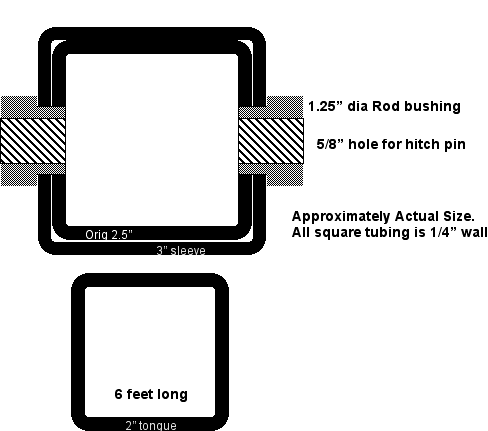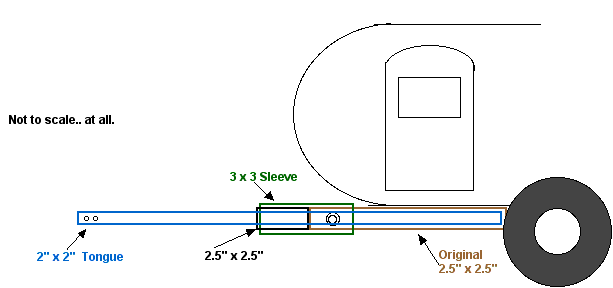
The problem with determining the strength of tongues is that we mostly only know of tongues that haven't broken, so they're either just strong enough or way too strong - and we never know which. So we should all thank Dave Nathanson for this useful post on his broken tongue shown above.
I've tried creating a Tongue Factor that attempts to measure how strong a tongue is. My suggestion is made up like this:
Tongue Factor = Load Factor / Section Modulus x 1000
Load Factor is a measure of how high the maximum bending moment on the tongue may be. It is some combination of total trailer weight, static tongue weight and the length of the tongue. My first shot is:
Load Factor = (1/4 total weight + tongue weight) x Sqrt of tongue length
The balance between total trailer weight and tongue weight (both in pounds) is my guess - it says a trailer with a 25% tongue weight would create twice the bending moment of a trailer with a zero tongue weight.
Tongue length (in inches) affects the bending moment fairly strongly - a longer tongue creates more bending moment - but I doubt it's linear, so I've used the square root of tongue length.
Section modulus is a calculated (and frequently published) property of a particular steel section, in in3 (inches cubed). The figure is doubled for an A-frame tongue 'cos it's got two sections/tubes.
The 1000 divisor is added to keep the result a useful size.
The Tongue Factor ends up in strange units of lb/in^2.5, so in honour of its inspiration it will be measured in 'kilodaves' - so once we've divided by the 1000, the result is in units of 'daves'.
The calculatuion for Dave's desert trailer looks like this:
Trailer weight = "about 1100 lb"
Tongue weight = "about 120 lb"
Tongue length = 40" (estimated from photos, hitch to tongue receiver)
Tongue section: 2x2x1/8" square tube with 3/4" horizontal hole.
Section modulus = 0.491 in3
Tongue Factor = 5.1 daves
Now that Dave has increased the tongue to 3/16" wall thickness, the section modulus has gone up to 0.672 in3 giving a new Tongue Factor of 3.7 daves, a 37% improvement.
Now this is valuable data because we know that 5.1 daves is in danger territory - although from Dave's descriptions of travelling on washboard roads, I suspect this was a fatigue failure and that in 'normal' road use it might be OK to get nearer 10 daves.
I have no idea what can be done with this idea, but maybe some of you will offer (polite) suggestions.
Andrew
PS For Bev, the Widget 6 with two 1/8" wall tubes has a Tongue Factor of 3.9 daves, so I reckon that's safe.











